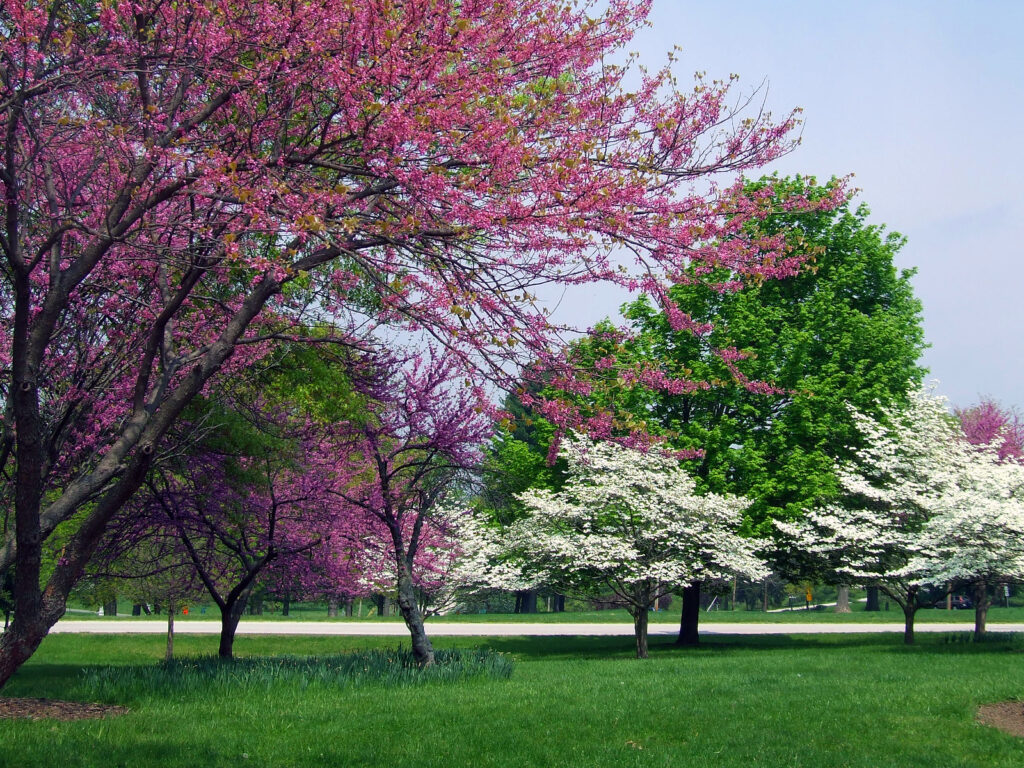Trees are the largest and longest-lived plants in the landscape. They bring beauty and serenity to the garden.
The time and effort spent in tree care are minuscule compared to the decades of pleasure they give.
Trees are relatively self-sufficient once established. Once a tree is established its care is mostly a matter of protecting it from damage.
Here are care basics for established trees:
Watering trees
- Water each week when less than 1 inch (2.5cm) of rain falls.
- Give trees a thorough soaking so that soil is moist to a depth of 2 feet (60cm). If necessary, loosen topsoil with a spading fork to facilitate penetration of water. Or use a tool designed to deliver water below the surface by means of a hollow, pointed rod.
- Trees grown in containers must be watered regularly and thoroughly.
- Water evergreens in winter to thaw the ground and provide water for the leaves especially if the weather is mild.
Mulching trees
- Mulching holds in moisture, inhibits weeds, and encourages soil organisms that aerate and enrich the soil.
- Mulch protects against soil overheating in summer and freezing and thawing in winter.
- Aged compost, peat moss mixed with soil, leaf mold, and untreated bark chips are useful mulches.
- Apply mulch in spring or early autumn when soil is moist and warm; mulch to 2 to 3 inches (5-7.5cm) deep.
- Keep mulch away from tree trunks; this ensures good air circulation and helps avoid rodent problems.
- Replenish mulch around trees as it gradually decomposes. Add just a few inches at a time.

Fertilizing trees
- Trees with small, yellow leaves or stunted twig growth or too few flowers or fruits likely have a nutrient deficiency and need feeding.
- Trees in lawns that are fertilized will need no additional fertilizer.
- Trees in isolated beds, in containers, or in paved areas may need a balanced organic fertilizer.
- Apply fertilizer in mid-spring and mid-autumn
- Apply tree fertilizer by broadcasting in on the soil surface. Or use slow-release-tree-food spikes that can be hammered into the soil. A soil auger can be used to bore 12-inch (30cm) holes into the soil, 18 to 24 inches (45-60cm) apart; granular fertilizer can be funneled into the holes.
- Follow fertilizer package application instructions; it is best to under-fertilize than overfertilize especially with inorganic synthetic fertilizers.
Pruning and training trees
- Trees can generally be pruned at any time of the year with the exception of beeches, birches, elms, and maples—these tend to bleed if pruned in spring. Prune oaks and evergreens trees in winter.
- Prune trees to correct structural problems and improve form.
- Remove diseased or dead wood. Also, remove damaged and broken branches.
- Remove crossing and rubbing branches by removing the weaker branches or cut off branches that grow into and across the center of the canopy.
- Remove suckers and curt out watersprouts. Trace a sucker to its point of origin belowground, grasp it firmly and pull it away cleanly; cutting encourages more suckers. Cut watersprouts off flush with the branch or trunk.
- Remove branches with narrow crotch angles.
Wrapping trees
- Newly planted trees can be protected from winter cold with a cloth or synthetic tree wrap; wrap will protect the bark for foraging animals and sunscald.
- Wrap from the soil line up the trunk to the first significant branches.
- Remove the wrap a month before the last expected frost in spring to avoid fungal diseases or insect infestations.
Tree wound care
- If a tree trunk or branch is damaged by machinery, wind or storms, or gnawing animals such as mice, rabbits, and deer, prompt wound treatment is necessary.
- Cut away dead or injured bark; do not cut into healthy tissue.
- Spray the wound with clean water.
- Apply moist sphagnum moss over the area and wrap a strip of white plastic tree wrap around the branch or trunk to protect it.
- Remove the moss in about two to three weeks.
- Commercial wound dressings are not necessary.
Raising the soil around trees
- Avoid raising the soil around trees; raising the soil level by just 2 inches can cut off feeder roots, dry out roots, cut off oxygen, and cause tree death.
- If the grade around trees must be changed, build a “well” of rocks around the trunk, keeping it a least a foot away. Spread coarse gravel at the raised level along with agricultural tiles in rows radiating from the well; then raise the grade. The purpose is to prevent roots from suffering from too much water.
Avoiding snow and ice damage
- If snow or ice bends a tree’s branches, do not shake the tree vigorously; branches may break. Allow the snow or ice to melt away naturally or gently sweep it off.
Avoiding salt damage
- Salt damage can cause tree leaves to become dry and brown along the edges. Overuse of chemical fertilizers can cause salt damage so can road salt.
- Salt can be flushed from well-drained soil with large volumes of water.
- Work gypsum into alkaline soil to help them become better drained.
Avoiding construction damage
- Keep construction back from trees. Avoid adding walks or driveways close to established trees; avoid building within the dripline of a mature tree or the dripline at maturity.
- Keep trucks and equipment away from trees; the weight can compact the soil and cause root damage or result in tree death.
Also of interest:















